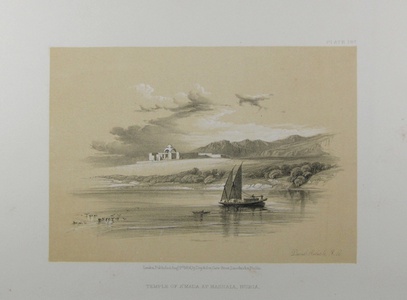| Method | Lithograph with tint stone |
| Artist | after David Roberts |
| Published | London, Published Augt. 1st. 1856, by Day & Son, Gate Street, Lincoln's Inn Fields |
| Dimensions | Image 124 x 175 mm, Sheet 200 x 295 mm |
| Notes |
Plate 187 from Volume 5 of the small format reprint of Roberts' The Holy Land, Syria, Idumea, Arabia, Egypt & Nubia. A view of the Temple of Amada, in the ancient Egyptian region of Nubia. The temple was built by the pharaoh, Thutmoses III, and dedicated to the state gods Amun and Ra-Horakhty. Thutmoses III was a warrior king, extending the Egyptian empire beyond the limits of any previous monarch, making the temple of Amada the oldest Egyptian temple in the region of Nubia. Although basic in form, the temple is endowed with beautifully executed and preserved wall reliefs, many of which retain their vibrant painted colour. The temple was moved in the 1960s from its original location near the Nile to a site some 65 metres higher to save it from rising flood waters from the expansion of the Aswan Dam. Due to the delicate interior reliefs, the temple was transported whole, rather than taken apart and reassembled. Roberts' view shows the temple on a plateau at the foot of some hills. A dome, now removed from the temple, suggests it was repurposed at some point as a Coptic church or Islamic mosque. In the foreground, a small sailing vessel and rowboat sail near to a flock of Nilotic waterfowl. David Roberts RA (24th October 1796 – 25th November 1864) was a Scottish painter. He is especially known for a prolific series of detailed prints of Egypt and the Near East produced during the 1840s from sketches made during long tours of the region (1838-1840). This work, and his large oil paintings of similar subjects, made him a prominent Orientalist painter. He was elected as a Royal Academician in 1841. The firm of Day & Haghe was one of the most prominent lithographic companies of the nineteenth-century. They were also amongst the foremost pioneers in the evolution of chromolithography. The firm was established in 1823 by William Day, but did not trade under the moniker of Day & Haghe until the arrival of Louis Haghe in 1831. In 1838, Day & Haghe were appointed as Lithographers to the Queen. However, and perhaps owing to the fact that there was never a formal partnership between the two, Haghe left the firm in the 1850's to devote himself to watercolour painting. The firm continued as Day & Son under the guidance of William Day the younger (1823 - 1906) but, as a result of a scandal involving Lajos Kossuth, was forced into liquidation in 1867. Vincent Brookes bought the company in the same year, and would produce the caricatures for Gibson Bowles' Vanity Fair magazine, as well as the illustrations for Cassells's Poultry Book, amongst other commissions. Condition: Light foxing to margins, not affecting image. |
| Framing | unmounted |
| Price | £30.00 |
| Stock ID | 39177 |

